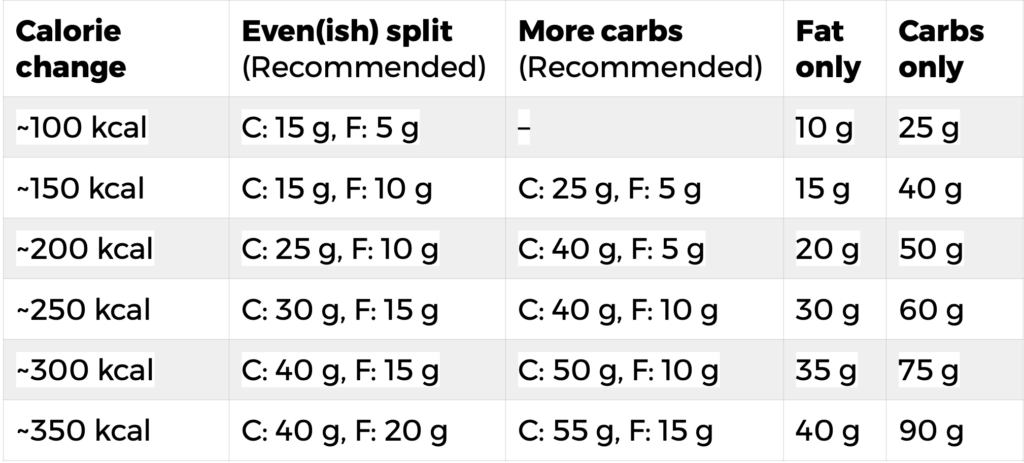When transitioning from a cut to a bulk, it is better to calculate the calorie increase needed using your progress data than making a fresh calculation with a calorie and macro calculator. This is because the equations behind calorie calculators only give estimations, and they cannot factor in any reduction in metabolic rate you’ve had when bulking. So, using a calculator risks setting your intake unnecessarily high, causing fat regain. (I’ve written in detail on this here.)
Fortunately, if you’ve been tracking your calorie intake and weight as I recommend, it’s just a case of simple math to find the appropriate addition to transition to a bulk.
Five STEPS TO TRANSITION TO A Bulk After Cutting
The transition from a cut to a bulk can be achieved in the following five steps:
Step 1: Increase calories to approximate maintenance. Estimate the calorie addition needed to approximate maintenance and add that to your daily intake.
Step 2: Wait two weeks. This allows your stomach adjust to the new, higher food intake level. (Optional, but recommended.)
Step 3: Increase calories to bulk. Calculate the calorie surplus needed to bulk at your target rate and add that to your daily intake.
Step 4: Wait four to six weeks. This will allow the weight gain trend in your data to become clear.
Step 5: Adjust if necessary. Make an adjustment, if necessary, to get yourself on track with your target rate of weight gain.
Note: If you are transitioning to a bulk from maintenance, skip the first two steps.
📖 Download our nutrition setup guide for free!
Calculations to Transition to a Bulk
👉 To find maintenance, multiply your average weekly weight change in pounds by 500, add that to your current daily calorie intake, and add your weight in pounds. (For metric users, multiply your average weekly weight change in kilos by 1100 and add your weight in kilograms x 2.2.)
👉 To gain 1 pound of weight per month, add 150 kcal each day. (330 kcal for 1 kg)
👉 Make the calorie additions in an approximate 2:1 ratio of carbs to fats.
Example Transition to a Bulk
Bob weighs 150 lbs. The calorie intake at the end of his cut is 1700 kcal. He has been losing 0.75 lbs per week, and as he is an intermediate trainee, so he decides to target 1.5% of his body weight per month (2.25 lbs) when bulking.
Step 1: He increases calories to approximate maintenance. Bob will first aim to increase his calorie intake by 525 kcal (0.75 x 500 + 150). He adds 85 g of carbs and 20 g of fats to his daily macros, for a total increase of 520 kcal.
Step 2: He waits two weeks. This allows his stomach to adjust.
Step 3: He increases calories to bulk. Bob will then aim to increase his calorie intake by ~337.5 kcal (2.25*150) to commence his bulk. He adds 15 g of fat and 50 g of carbs to his daily macros for a total increase of 335 kcal.

Step 4: He waits four to six weeks. This allows the trend in his weight data to become clear.
Step 5: He adjusts as necessary. Bob finds that he is gaining weight 1 lb per month short of his target so he increases his calorie intake by 150 kcal per day. He can add 25 g of carbs and 5 g of fat for a total increase of 145 kcal.
Here’s how that looks:

Bob’s transition to a bulking phase is now complete. But it is not over because he will need to continually track and adjust as his metabolism adapts.
You will probably have to adjust YOUR calorie intake more than you imagine To Keep Progressing
At the end of your cut, your metabolism will have adapted and it may have been a struggle to adhere. The calculations in steps 1 and 3 might give numbers lower than you would think, disappointing you. However, don’t forget that metabolic adaptation happens when we bulk also, meaning we have to keep adjusting our calorie intake upward to keep progressing.
This means that while you might end your cut at 1700 calories and losing 1 pound per week, you may have to eventually increase your calories to 3800 each day to achieve 3 pounds of weight gain per month, rather than the 2800 you initially calculated.
Patience is vital to transition to the bulk successfully. If you increase calories too quickly, you risk regaining too much fat.
To complete your bulk, follow the guidelines in the How To Adjust Calories and Macros As You Bulk To Minimize Fat Gain chapter. Once the bulk is done, follow the instructions in the How To Find Maintenance Calories chapter or How To Cut After Bulking chapters, based on your goal.

Privacy policy.